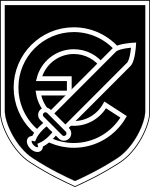20th Waffen Grenadier Division of the SS (Estonian No. 1)
|
20th Waffen Grenadier Division of the SS (Estonian No. 1) |
|
|---|---|
 Troop registration |
|
| active | January 24, 1944 to May 1945 |
| Country |
|
| Armed forces |
|
| Branch of service | Grenadiers |
| Type | division |
| structure | See outline |
| Butcher | Eastern Front |
| commander | |
| list of | Commanders |
The 20th Waffen Grenadier Division of the SS (Estonian No. 1) ( Estonian 20th relvagrenaderide SS-diviis / 20th Eesti SS-vabatahtlike diviis ) was a grenadier division of the Waffen SS in World War II . A large part of the troops and officers consisted of Estonian volunteers and Estonians drafted for military service.
history
The unit called the Estonian Legion had already existed from October 1942 to May 1943 and was converted into the 3rd Estonian SS Volunteer Brigade on May 5, 1943 . The unit was declared a division on January 24, 1944 under the name of the 20th Estonian SS Volunteer Division . On May 26, 1944 it was named the 20th Waffen Grenadier Division of the SS (Estonian No. 1) . An Estonian battalion "Narwa" was part of the SS division "Wiking" .
As early as February 1944, the division was deployed on the Narva , initially as a brigade . With the breakthrough of the Red Army in the Sillamäe area , the 20th Waffen Grenadier Division of the SS was massively weakened and finally smashed.
On October 6, 1944, the new installation took place in Neuhammer (Queis) , Silesia. Units of the division fought in East Prussia until January 1945. When the major Soviet offensive began in January 1945, the division was moved to Silesia , where it was subordinate to the 17th Army as a combat group .
The withdrawal in February 1945 extended to the Striegau area , where parts of the division with the division headquarters in the Neustadt OS area were surrounded by Soviet units. The SS-Freiwilligen-Grenadier-Regiment 46 (Estonian No. 2) came to the aid of the encircled and fought the way for some combat groups and the division staff out of the cauldron. The division commander Franz Augsberger was killed in this action . Until his successor Berthold Maack arrived , Alfons Rebane temporarily took over the leadership of the division as deputy commander. The broken-fighting groups fought with the loss of all heavy weapons to Bohemia by where they at on May 11, 1945 Mělník , northeast of Prague in Soviet captivity came. Parts of the division managed to escape westward into American captivity.
Areas of application
- January to March 1944: Establishment of the division in the area of Army Group North
- March to September 1944: deployed in northeast Estonia
- November 1944 to May 1945: Deployment in Silesia and Bohemia as part of Army Group Center
structure
- SS Volunteer Grenadier Regiment 45 (Estonian No. 1)
- SS-Freiwilligen-Grenadier-Regiment 46 (Estonian No. 2)
- SS Volunteer Grenadier Regiment 47 (Estonian No. 3)
- SS Volunteer Artillery Regiment 20th
- SS Volunteer Division Fusilier Battalion 20th
- SS tank destroyer division 20
- SS Volunteer Flak Department 20
- SS Volunteer Pioneer Battalion 20th
- SS News Department 20
- Supply units 20
Commanders
- August 20, 1942 to March 19, 1945: SS Brigade Leader and Major General of the Waffen SS Franz Augsberger
- March 19, 1945: SS-Sturmbannführer Hans-Joachim Mützelfeldt
- March 20, 1945 to May 8, 1945: SS-Brigadefuhrer and Major General of the Waffen-SS of the Reserve Berthold Maack
Historical classification and assessment

In Estonia, members of the Waffen SS are now often viewed as "freedom fighters". Nationalist forces operate a corresponding public honor as "fighters against the communist dictatorship". In March 2012, parliament passed a resolution claiming that members of the 20th Waffen SS Division were freedom fighters. The Estonian side always emphasizes that the relatives only fought for the freedom of Estonia and allegedly had nothing to do with the war crimes of the SS.
literature
- Rolf Michaelis : Estonians in the Waffen SS. The 20th Waffen Grenadier Division of the SS (Estonian No. 1). Winkelried-Verlag, Dresden 2006, ISBN 978-3-938392-22-5 .
- Georg Tessin : Associations and troops of the German Wehrmacht and Waffen SS in World War II 1939–1945. Volume 4. The Land Forces 15–30 . 2nd Edition. Biblio-Verlag, Osnabrück 1976, ISBN 3-7648-1083-1 (especially p. 150 f.).
- Karl H. Thiele: Beyond "Monsters" and "Clowns". The Combat SS. University Press of America, Lanham 1997, ISBN 0-7618-0529-X , pp. 348 f.
Web links
- 20th Waffen Grenadier Division of the SS (Estonian No. 1) in the inventory overview of the Federal Archives
- www.eestileegion.com (Estonian and English)
Individual evidence
- ↑ 20th Waffen Grenadier Division of the SS (Estonian No. 1) ( Memento from April 2, 2015 in the Internet Archive ) in the inventory overview of the Federal Archives.
- ^ J. Lee Ready: The Forgotten Axis. Germany's Partners and Foreign Volunteers in World War II. Jefferson, North Carolina / London 1987, p. 491.
- ↑ Cf. Georg Tessin : Associations and troops of the German Wehrmacht and Waffen-SS in the Second World War 1939–1945. Volume 4. The Land Forces 15–30 . 2nd Edition. Biblio-Verlag, Osnabrück 1976, ISBN 3-7648-1083-1 (especially p. 150 f.).
- ↑ For the commanders see Samuel W. Mitcham : German Order of Battle: Panzer, Panzer Grenadier, and Waffen SS divisions in World War II . Stackpole Books, 2007, ISBN 0-8117-3438-2 , p. 171. And: Andreas Schulz, Günter Wegmann, Dieter Zinke: The generals of the Waffen-SS and the police: Lammerding-Plesch , Biblio-Verl., 2003, ISBN 3-7648-2375-5 , p. 100.
- ↑ Sven Felix Kellerhoff : Estonia is considering honoring the Waffen SS. In: The world. January 12, 2012, accessed January 23, 2012 .
- ↑ http://www.ag-friedensforschung.de/regionen/Estland/ss3.html